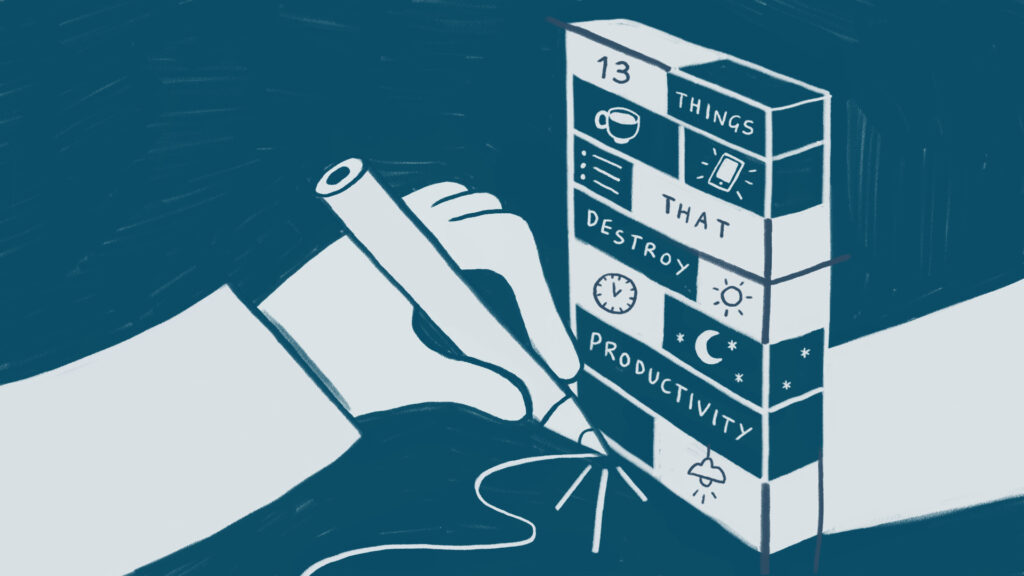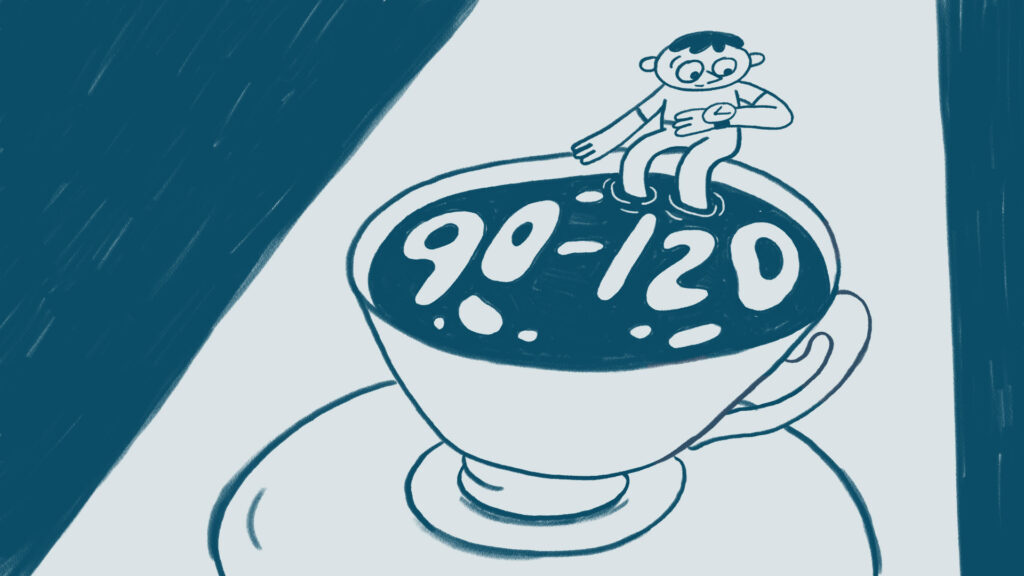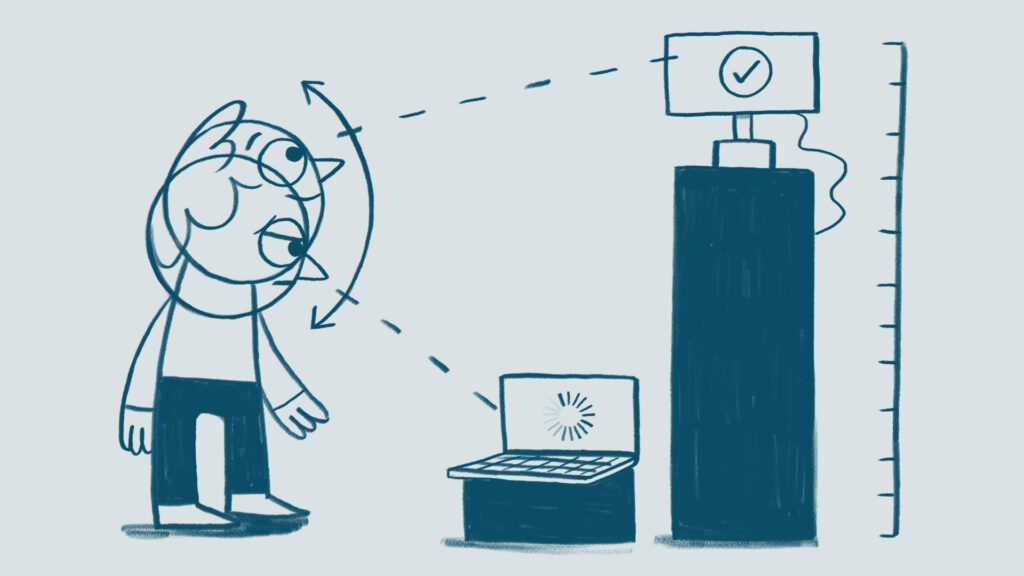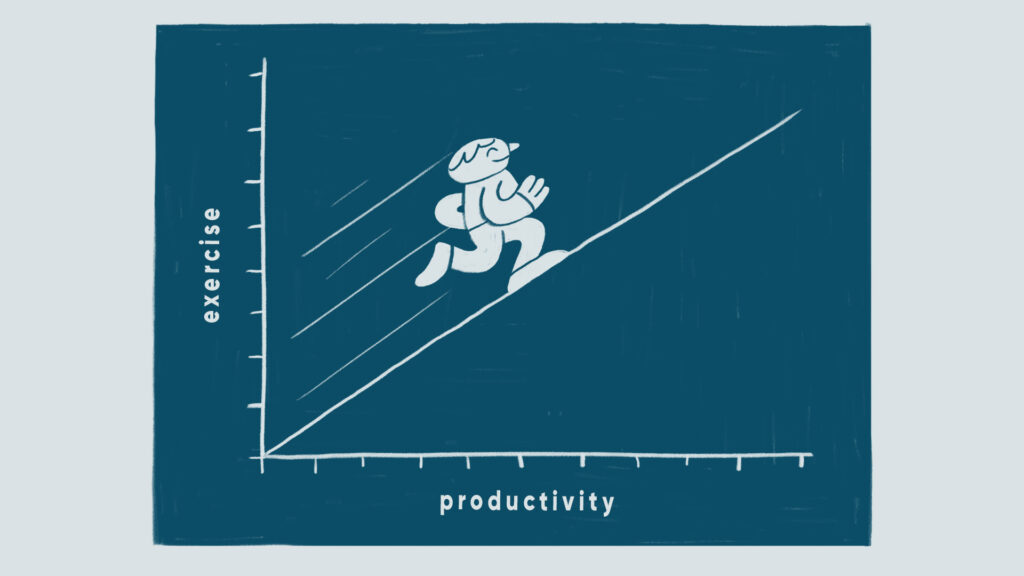I don’t drink coffee until 90 minutes after I wake up, I never sacrifice sleep, food, or exercise for extra work time, and I always position my computer screen at a certain height. Why do I do these weird things? I found 13 things in peer-reviewed articles and from anecdotal experience that destroy productivity. In this post, I’ll tell you those 13 things so you can avoid them.
Let’s get into it.

Working at the Wrong Time
Our brains are optimized to do hard work at different times.
Avoid Sleep Inertia.
Your best work probably will not be completed in the first hour after you wake up because of the concept of sleep inertia. Sleep inertia posits that our brains are still “warming up” in the first hour after waking up in the morning. Then, our performance improves to optimal at around 2-4 hours after waking up.
One study looked at fifteen people and had them do simple summation problems at different times after waking up; they found people could do the most and fastest summation about 2-4 hours after waking.1
Another important point is that cortisol is a huge driver of how awake we are in the morning and when we can be the most productive. And according to one study, cortisol levels don’t peak until about 30-45 minutes after waking up.6
So, to avoid sleep inertia, and complete your best work, wait at least one hour after waking before beginning work. Also, around 1 hour after waking is also the best time to do harder more mundane work because of this peak in cortisol.
Caffeine Intake
Drink Caffeine 90-120 Minutes After Waking Up
Wait to drink caffeine until 90 minutes to 120 minutes after you wake up. This tip is from Dr. Huberman and his podcast, and the rationale is that cortisol levels are very high in the first hour or two after waking up, as we showed earlier, and that is what wakes us up. The morning coffee is not waking you up; it is the cortisol. Caffeine, in fact, probably does very little, if anything, that soon after waking.
Caffeine doesn’t “add energy,” the only thing caffeine does is forestall sleepiness. Caffeine is an adenosine receptor antagonist, which blocks adenosine from doing what it usually does. But what’s adenosine, and what happens if we stop it?
The current understanding of adenosine is that it is a “counter” to sleep debt. When you first wake up in the morning, the amount of adenosine bound to these receptors is low because, as you sleep, adenosine is freed from these receptors because of sleep. The more adenosine receptors bound by adenosine, the more sleepy you are. As the day goes on, adenosine slowly accumulates on these receptors, increasing your “sleepiness.” When you drink caffeine, it blocks adenosine binding and, therefore, blocks “sleepiness.”7

So, when we first wake up in the morning, if we’ve had a good night’s sleep, there are relatively low amounts of adenosine bound to the adenosine receptor. So, what’s the point of blocking adenosine binding with caffeine if very little adenosine is binding anyway? There isn’t a point, because those adenosine receptors got cleared overnight as we slept. So, we should wait until caffeine can have more of an impact, the time at which cortisol starts to drop, and when more adenosine receptors might be bound, which is why Dr. Huberman and I wait 90-120 minutes after waking up to drink coffee. This delay has the added benefit of delaying the afternoon crash because if we drink coffee at a later point in the day, it will stay in our bodies later as well. Delaying the “sleepiness” feeling for longer into our day.
Screen Positioning
There is a physiological mechanism in our body that when we are looking up, it increases levels of alertness, but when we look down, the opposite is true; it decreases our levels of alertness.
When you look down to the ground, you signal your body to be less alert. When you look up, it makes your body more alert. So, if you are always looking down at your screen you are lowering your alertness.
I match my forehead to the top of my studio monitor when sitting as tall as I can. That way, when I’m usually slumped down a little, I am maybe glancing up a little bit, but if I am sitting up, I am likely looking straight on or only slightly downward. Your monitor probably needs to be higher than you think. Keep it at eye level at least.
Staying Static
“Sedentary is the new smoking,” not “sitting is the new smoking.”11 That’s from a paper discussing standing desks and their benefit.
Alternating between sitting and standing is excellent. I have a standing desk, and I switch between sitting and standing for every Pomodoro session. So, one session I am sitting, then the next I am standing. According to the research, it seems just standing or sitting is bad news, we should be moving around as much as we can. The worst thing is staying in the same place and not moving for extended periods.5,6 This is one reason why people are more at risk for pulmonary embolism after sitting still on long flights. And why very sick patients who cannot move at all are made to move by nurses or care providers at regular intervals. The human body is not meant to be completely still for extended periods. Try to be moving in some way, more often than not.

I alternate Pomodoro sessions with sitting and standing. One session, I sit, the next, I stand, and so on. I also like to try balancing on a weird beam or something funny to increase my movement even more.
I also like to break up my studying with exercise; this not only gives your brain a break but also gives you the chance to change your body’s position more dramatically.
Using Light Improperly
Using light properly will help us get better sleep and regulate our alertness. Another goldmine of a tip from Dr. Huberman and it is further supported by a recent publication in March 2022 reviewing optimal lighting conditions.8 Let’s break it down into three and a half phases.
- Phase 1: From waking up to 8 hours after waking up, we have higher levels of these alertness chemicals such as dopamine, norepinephrine, and cortisol; we should be taking advantage of that to do our best and hardest work. Encourage this early cortisol spike with early morning exposure, sunlight 10 – 30 minutes after waking. Another thing I like to do is always have the overhead lights on in my apartment. I need as much light hitting those retinas as I can get! (Sciency terms: minimum melanotic EDI (equivalent daylight illuminance) is 250 lux; daylight should be used first, but if using electric lighting it should be polychromatic white light with enriched shorter wavelengths similar to mimic sunlight)
- Phase 2: 8 to 13 hours after waking up, the alertness chemicals start to fade, and serotonin levels become higher; Dr. Huberman argues we are more creative now. I tend to agree; the only alteration is, usually, I can’t work well past ~14 hours after waking. At that time, I turned off the overhead lights and began winding down.
- Phase 2.5 13-16 Hours (At least three hours before bed) the light should be reduced around you. That means turning off the overhead lights and switching to candles or soft red lights. This also means we technically should not be viewing the TV or phone. I can’t do that, so I turn out all the lights one hour (instead of three) before bed and stop all electronics. I shower, lit by a candle, and read, by a red bulb in my lamp. (Science stuff: recommended maximum melanotic EDI is 10 lux, this time, the light should be depleted of short wavelengths to less mimic daylight).
- Phase 3: 16 – 24 Sleep. We want blackness at this point. (Maximum ambient melanopic EDI is 1 lux)
Not Sleeping
People who don’t sleep perform worse at nearly everything. This is why there are rules for truck drivers, medical practitioners, and pilots about work time and sleep. There are laws around these things because of how vital sleep is to performance.
Poor sleep, less than ~6.5 hours per night, increases the chance of accidents, decreases work performance, worsens mood, slows reaction time, impairs attention, worsens memory, and that’s just the beginning.2
Not sleeping even removes that lovely cortisol pump we want early in the morning. In one study, 40 participants were randomly assigned to total sleep deprivation or a sleep condition. Remember how I talked about how vital cortisol was and how it spikes in the morning waking up our brains and our body? Well, it was found from this study that if you are sleep deprived, there is no increase in morning cortisol. Bad news if we want an awake brain!5
Well, what if I take a nap later in the day? Can’t I fix it and get my cortisol spike back? Wrong; one study looking at the cortisol awakening response noted this cortisol increase was absent in afternoon nap awakenings compared to morning awakenings for people with a regular sleep/wake cycle.6
It’s really hard to trick our body into thinking we got a full night’s rest, when we didn’t get a full night’s rest, so get a full night’s rest!
One estimate suggests the cost to the US GDP is 2.4% because of poor sleep from absenteeism, accidents, and reduced productivity.9,10 They even go on further to say that getting proper sleep, so going from <6 hours of sleep per night to simply a standard of 7 hours per night, could increase the GDP by 1.7% or 300 billion dollars annually.10
For the sake of America, or whatever country you live in, get some good sleep!
I’ve listed these tips over and over but here are the best tips I’ve found for getting better sleep:
- Consistent wake and sleep time
- Bright outdoor light exposure for 10-30 minutes within 10-30 minutes after waking up.
- No exercise 5 hours before bed.
- No more eating or bright lights 3 hours before bed.
- Avoid screens at least 1 hour before bed.
- Avoid naps longer than 15 minutes
- Have a wake and sleep routine; my sleep routine, for example, reading, flossing and brushing teeth, showering or bath, may be reread, then sleep.
- Have your room very dark, very cold, and very quiet
Not Exercising
Exercise improves sleep, memory, anxiety, depression, all-cause mortality, chronic disease, and premature death.12,13 Exercise is a fantastic break from the computer and sitting. I prefer to exercise about halfway through my day if I can control it, however, the most important thing is that you exercise at all. Exercise can do some fantastic things for our memory and focus.

Molecules such as IGF-1 are released during exercise that may be responsible for maintaining brain cells and are also directly related to spatial learning and memory.14,15 Another molecule, brain-derived neurotrophic factor (BDNF), a significant modulator of brain plasticity, is also released more during exercise than non-exercise.16 Evidence shows that activity (or exercise) in humans and mice increased hippocampal neurogenesis (the part of our brain responsible for memory), cell proliferation, and dendritic branching.17-19
Also, exercise is proven to reduce stress and anxiety, and studies show stress and anxiety past a certain point hinder performance.20
So exercise! The American Heart Association (AHA) recommends 150 minutes of exercise per week.
Letting Yourself Be Distracted
This is the way I most commonly lose focus, the way I am often not productive. Currently, this is the thing I need to work on the most.
I love messaging my friends, watching YouTube videos, looking at YouTube comments, going on Twitter, and checking my emails. To be perfectly honest, I haven’t found a good solution for stopping myself from doing these things.
The research says distractions decrease performance. One study looked at surgery residents and added a distraction, and another looked at drivers and distractions; both indicate more distractions equals worse performance.21,22 I find myself wanting to reach for the phone way too often; writing this post, for example, in the back of my head, the urge is there to grab my phone. Being aware of it helps, but why is it still there?
The only consistent solution for me has been the Pomodoro method, but after all my schoolwork is done, what about focusing on other things? Like this YouTube stuff or writing or reading. I find myself doing “bad” things like YouTube, video games, TV, etc. So, here is what I am currently trying to do to be less distracted:
- Improve mindfulness with a daily 20-minute meditation practice
- (Thomas Frank tip) Log out of all social media on my phone, then I allow myself to check it for one hour on Sunday
- Having “zones” where the phone is not permitted, my reading corner, the bathroom, my bed, and my desk.
- Use the self-control app when I keep browsing the internet
- Setting a max of 1-hour total per day of TV and video games
Depending on Motivation
The difference between a hobbyist and a professional is consistency. Professionals know they have to do it. So they show up and get the work done. Hobbyists depend on motivation.
Time blocking has been extremely helpful for me here; I block out precisely what I will be doing every day. I have time set for medical school stuff, time for the most critical task of the day (like writing or editing this post), time for exercising, time for cooking and eating dinner, and time for bed. If it’s in the calendar, I do it; it is in the calendar, after all.
Don’t depend on motivation. Be a professional at what you want to do if you want to be a professional at what you want to do. I like this whole internet thing and the idea of being a doctor, so I act like a professional at those things. That means working certain hours and always showing up.
Not Having a Goal
Set concrete goals, the more specific the plan, the more likely you will accomplish it (this is backed by research).23 I find it helpful to know exactly what I am doing in a couple of ways and break that goal down. Every night I plan exactly what I will be doing the next day by writing down what I will do on a post-it note. It helps me keep my tasks organized. The next day, when I wake up, I just look at the post-it note and cross out the things as the day goes on.
Also, regarding task difficulty, the 85% rule is heavily backed by research. The job you are working on, whatever you are learning, you should get right about 85% of the time with 15% of the time making errors; that seems to be the critical number for the most significant rate and efficacy of learning.24
I target this number with my flashcards, reading, guitar, cooking, and everything I want to get better at because of this research. The general feeling is “ok, I know what’s going on, I get the gist, but occasionally I mess up.” The bad feeling is when you feel so lost you can’t even begin to work or it’s so easy that you are doing 900 other things in the background so you don’t get bored.
Having Dull Tools
Have the best tools for what you do (within reason). Of course, there are diminishing returns. Doctors in the developed world have better outcomes for their patients than in the developing world not just because of increased training but also because of improved technology; better tools.
But, it doesn’t have to be that advanced; if you are a runner, research and buy the best shoes beyond regular walking shoes.
A video editor will benefit significantly from having the fastest computer they can reasonably afford.
A truck driver can carry much more cargo than a horse and buggy. No matter how much the horse and buggy driver perfected that system, he stood no chance against the modern-day truck.
Importantly, this doesn’t just apply to tangible tools. Mental capacities are also necessary. Writers can’t take years and years off writing and jump back to exactly where they were. Healthcare providers are continuously tested on their abilities and are continually going through continued education. Sharpen your mental skills for the work you will be doing.
Not taking a break
I mentioned this earlier, but Pomodoro sessions or taking breaks is vital.
I work in cycles; I like 25/5 or 50/10. Anything beyond 90 minutes of straight work is complicated. I find that is the absolute max time of deep focus you can accomplish. Going past 90 minutes of actual focused work is tough, and the evidence supports this.3,4
My favorite break is going outside for a walk, going outside also gives you eye breaks
Having Tunnel Vision
Finally, grow outside of whatever task you are performing. The most resilient environmental ecosystems are the most diverse.25 All the best doctors I know also have well-rounded personal lives. When growing indoor plants, you need to turn them constantly so they don’t grow too much on one side; if you never turn the plant, it will grow lopsided and fall over.
This is why I try to read, meditate, exercise, do yoga, and speak to mentors outside of medicine and YouTube. If I only focused on YouTube or only focused on medicine, I think I would be worse at those activities. When I started medical school I stopped exercising, talking to friends, and cooking. I wanted only to be the best possible medical student I could be. Guess what? My grades were worse than ever. When I brought back exercise, friends, and my everyday life things, my studying and time went working went down, and my grades went up.
Thanks for reading! Hopefully, this makes you more productive.
Work Cited
- Randler, C. (2009). Proactive people are morning people1. Journal of Applied Social Psychology, 39(12), 2787–2797. https://doi.org/10.1111/j.1559-1816.2009.00549.x
- Oken BS, Salinsky MC, Elsas SM. Vigilance, alertness, or sustained attention: physiological basis and measurement. Clin Neurophysiol. 2006 Sep;117(9):1885-901. doi: 10.1016/j.clinph.2006.01.017. Epub 2006 Apr 3. PMID: 16581292; PMCID: PMC2865224.
- Mclean L, Tingley M, Scott RN, Rickards J. Computer terminal work and the benefit of microbreaks. Appl Ergon. 2001 Jun;32(3):225-37. doi: 10.1016/s0003-6870(00)00071-5. PMID: 11394463.
- Gobbo, Federico & Vaccari, Matteo. (2008). The Pomodoro Technique for Sustainable Pace in Extreme Programming Teams. 10.1007/978-3-540-68255-4_18.
- Vargas I, Lopez-Duran N. The cortisol awakening response after sleep deprivation: Is the cortisol awakening response a “response” to awakening or a circadian process? J Health Psychol. 2020 Jun;25(7):900-912. doi: 10.1177/1359105317738323. Epub 2017 Oct 27. PMID: 29076400.
- Elder GJ, Wetherell MA, Barclay NL, Ellis JG. The cortisol awakening response–applications and implications for sleep medicine. Sleep Med Rev. 2014 Jun;18(3):215-24. doi: 10.1016/j.smrv.2013.05.001. Epub 2013 Jul 5. PMID: 23835138.
- Urry E, Landolt HP. Adenosine, caffeine, and performance: from cognitive neuroscience of sleep to sleep pharmacogenetics. Curr Top Behav Neurosci. 2015;25:331-66. doi: 10.1007/7854_2014_274. PMID: 24549722.
- Brown TM, Brainard GC, Cajochen C, Czeisler CA, Hanifin JP, Lockley SW, Lucas RJ, Münch M, O’Hagan JB, Peirson SN, Price LLA, Roenneberg T, Schlangen LJM, Skene DJ, Spitschan M, Vetter C, Zee PC, Wright KP Jr. Recommendations for daytime, evening, and nighttime indoor light exposure to best support physiology, sleep, and wakefulness in healthy adults. PLoS Biol. 2022 Mar 17;20(3):e3001571. doi: 10.1371/journal.pbio.3001571. PMID: 35298459; PMCID: PMC8929548.
- Koritala BSC, Cakmakli S. The human circadian clock from health to economics. Psychiatry J. 2018;7(4):176–96. doi: 10.1002/pchj.252
- Hafner M, Stepanek M, Taylor J, Troxel WM, van Stolk C. Why sleep matters-the economic costs of insufficient sleep: A cross-country comparative analysis. Rand Health Q. 2016;6(11).
- Mula A. Ergonomics and the standing desk. Work. 2018;60(2):171-174. doi: 10.3233/WOR-182736. PMID: 29865102.
- Kelley GA, Kelley KS. Exercise and sleep: a systematic review of previous meta-analyses. J Evid Based Med. 2017 Feb;10(1):26-36. doi: 10.1111/jebm.12236. PMID: 28276627; PMCID: PMC5527334.
- Mora JC, Valencia WM. Exercise and Older Adults. Clin Geriatr Med. 2018 Feb;34(1):145-162. doi: 10.1016/j.cger.2017.08.007. Epub 2017 Oct 10. PMID: 29129214.
- Cassilhas RC, Tufik S, de Mello MT. Physical exercise, neuroplasticity, spatial learning and memory. Cell Mol Life Sci. 2016 Mar;73(5):975-83. doi: 10.1007/s00018-015-2102-0. Epub 2015 Dec 8. PMID: 26646070.
- Gomez-Pinilla F, Ying Z, Opazo P, Roy RR, Edgerton VR (2001) Differential regulation by exercise of BDNF and NT-3 in rat spinal cord and skeletal muscle. Eur J Neurosci 13:1078–1084
- Máderová D, Krumpolec P, Slobodová L, Schön M, Tirpáková V, Kovaničová Z, Klepochová R, Vajda M, Šutovský S, Cvečka J, Valkovič L, Turčáni P, Krššák M, Sedliak M, Tsai CL, Ukropcová B, Ukropec J. Acute and regular exercise distinctly modulate serum, plasma and skeletal muscle BDNF in the elderly. Neuropeptides. 2019 Dec;78:101961. doi: 10.1016/j.npep.2019.101961. Epub 2019 Aug 29. PMID: 31506171.
- Stranahan AM, Khalil D, Gould E (2006) Social isolation delays the positive effects of running on adult neurogenesis. Nat Neurosci 9:526–533
- van Praag H, Christie BR, Sejnowski TJ, Gage FH (1999) Running enhances neurogenesis, learning, and long-term potentiation in mice. Proc Natl Acad Sci 96:13427–13431
- van Praag H, Shubert T, Zhao C, Gage FH (2005) Exercise enhances learning and hippocampal neurogenesis in aged mice. J Neurosci 25:8680–8685
- Lupien, Sonia J., and Bruce S. McEwen. “The acute effects of corticosteroids on cognition: integration of animal and human model studies.” Brain research reviews 24.1 (1997): 1-27.
- Hughes MA, Swan L, Taylor CL, Ilin R, Partridge R, Brennan PM. The Impact of Novel Nontechnical Stressors (Visual and Auditory) on Simulated Laparoscopic Task Performance Among Surgeons and Students. J Laparoendosc Adv Surg Tech A. 2022 Feb;32(2):189-196. doi: 10.1089/lap.2021.0695. Epub 2021 Dec 2. PMID: 34860611.
- Zhang Y, Kaber DB, Rogers M, Liang Y, Gangakhedkar S. The effects of visual and cognitive distractions on operational and tactical driving behaviors. Hum Factors. 2014 May;56(3):592-604. doi: 10.1177/0018720813495279. PMID: 24930178
- Balcetis E, Riccio MT, Duncan DT, Cole S. Keeping the Goal in Sight: Testing the Influence of Narrowed Visual Attention on Physical Activity. Pers Soc Psychol Bull. 2020 Mar;46(3):485-496. doi: 10.1177/0146167219861438. Epub 2019 Jul 19. PMID: 31322053.
- Wilson, R.C., Shenhav, A., Straccia, M. et al. The Eighty Five Percent Rule for optimal learning. Nat Commun 10, 4646 (2019). https://doi.org/10.1038/s41467-019-12552-4
- Henderson CJ, Gilby BL, Schlacher TA, Connolly RM, Sheaves M, Maxwell PS, Flint N, Borland HP, Martin TSH, Olds AD. Low redundancy and complementarity shape ecosystem functioning in a low-diversity ecosystem. J Anim Ecol. 2020 Mar;89(3):784-794. doi: 10.1111/1365-2656.13148. Epub 2019 Dec 24. PMID: 31758695..
